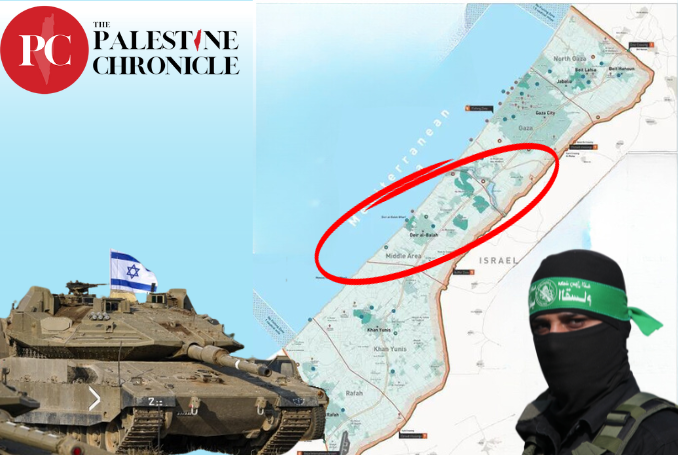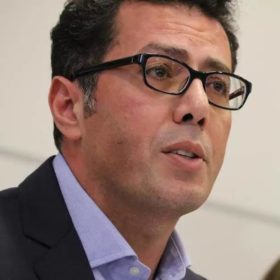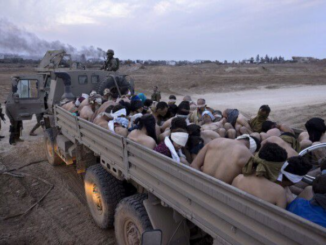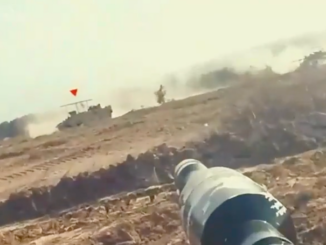
By Ramzy Baroud 
Israel has tried and failed in both the north and the south. It is desperately trying to change the rhythm of the fighting to achieve political goals.
Throughout the night and well into the day on Wednesday, Israeli warplanes bombed, without remorse, the area between Juhr Al-Dik and Al-Mughraqa.
This relentless series of strikes was included in news headlines as if part and parcel of the savage Israeli war on the besieged Gaza Strip.
But the massive destruction underway in the area between Juhr Al-Dik – which separates the northern and central Gaza regions, and Al-Mughraqa – located at the north end of central Gaza, is not random.
Twenty days into its aerial bombardment of Gaza, Israel launched its ground offensive from the north, and precisely from areas it deemed to be less defensible from the Palestinian Resistance standpoint. These areas included Juhr Al-Dik.
In this just-released video, Al-Qassam fighters are seen Targeting enemy soldiers and destroying their vehicles that infiltrated the axes of Khan Younis city in the southern Gaza Strip.
FOLLOW OUR LIVE BLOG:https://t.co/KvZsuXqOVh
ARABIC TEXT TRANSLATION:
01:30 – "Targeting… pic.twitter.com/4ieCnPIQZ5
— The Palestine Chronicle (@PalestineChron) December 27, 2023
But Why Juhr Al-Dik?
Juhr Al-Dik is a small agricultural village, consisting of a small population of only a few thousand, who live atop whatever land Israel has not confiscated as part of its ‘security-belt’ region, separating besieged Gaza from Israel.
The distance between the houses largely depends on the ownership of the land belonging to those Palestinian farmers.
Aside from the relative ease by which Israel managed to invade Juhr Al-Dik in the early days of the land invasion, Israel’s control over the area also carried a strategic purpose: starvation.
Indeed, the eastern parts of the Gaza Strip represent the food basket of a besieged population that relies largely on the little imports allowed by Israel, mostly through Kerem Ben Salem (Kerem Shalom) Crossing.
The rest comes from Gaza’s own agricultural production.
Controlling these agricultural areas meant tightening the noose around the collective neck of a struggling and browbeaten population.
Juhr Al-Dik also served another strategic objective for Israel, as it is, more or less, a meeting point between northern and central Gaza.
In fact, the Israeli military command in Gaza was partly based in Juhr Al-Dik since the area was perceived to be safest for permanent Israeli military presence.
In this just-released video, Al-Qassam fighters are seen targeting enemy soldiers and destroying their invading vehicles into the Shuja’iya neighborhood, east of Gaza City.
FOLLOW OUR LIVE BLOG:https://t.co/KvZsuXqOVh pic.twitter.com/L8ZUpJmDUg
— The Palestine Chronicle (@PalestineChron) December 27, 2023
But Did Israel Meet its Objectives?
No. To the contrary, the ongoing resistance in Juhr Al-Dik continues to represent an embarrassment for the Israeli military as the Palestinian Resistance carried on striking Israeli troops, penetrating Israeli defenses, and killing Israeli soldiers at point-blank distances.
Why is Israel now Bombing the Area between Juhr Al-Dik and Al-Mughraqa?
With the splendid failure of Israel to fully control northern Gaza and its ongoing failure to besiege Khan Yunis in the south, Israel is desperate for more options.
On December 23, Israeli tanks attempted to penetrate the Philadelphi Route, the border region between the Palestinian town of Rafah in the south and the Egyptian border.
It remains unclear what happened following that attempt. But it seems that a strong Egyptian rejection, along with stiff Palestinian resistance, have prevented Israel from penetrating deeper into the area, with the hope of reaching the Mediterranean Sea in the west.
It was then that Israel carried out massacres in Al-Maghazi, Bureij, and Deir Al-Balah in central Gaza starting on Sunday.
The initial analysis then was that the Israeli military was taking out its frustration on the most populated areas in Gaza to avenge its many soldiers who were killed and wounded in recent battles.
As savage as these massacres were, that was not the main goal.
AL-QASSAM BRIGADES:
Our fighters targeted 7 Israeli vehicles with Al-Yassin 105 shells in Jabalia Al-Balad, killing and wounding a number of soldiers.
We targeted a special Zionist unit fortified in a house in the Jabaliya Al-Balad area using an RPO-A anti-fortification missile… pic.twitter.com/xpTUUFwOFB
— The Palestine Chronicle (@PalestineChron) December 27, 2023
What was the Goal?
Israel is now hoping that it will be able to cut off northern and central Gaza from the Juhr Al-Dik/Mughraqa axis; and central and southern Gaza from Maghazi/Deir Al-Balah axis.
By doing so, Israel will be able to further sectionalize the Gaza Strip and to strengthen its military presence at both northern and southern fronts.
Will Israel Succeed?
Unlikely. It seems that Israel’s early goal from its invasion was to displace Palestinians out of Gaza entirely. So, it carpet-bombed northern Gaza in ways arguably unparalleled in modern history.
Naturally, over a million people ran away seeking shelter in the center and the south.
But when Israel began attacking the south, the Khan Yunis region in particular, a large number of already-displaced Palestinians also escaped to the center of Gaza.
The population of a refugee camp like Nuseirat in central Gaza, for example, has increased by several folds, from 100,000 on October 6 to an estimated half a million, if not more.
In order for Israel to create a corridor between Bureij, which borders Israel in the east, and the Mediterranean, it would have to go through Nuseirat.
Expectedly, the bloodbath that would occur for this to be achieved could parallel, if not even exceed, the grisly massacres of Shati, Jabaliya, and Khan Yunis.
ISRAELI CHANNEL 12: A soldier from the Paratroopers Brigade returning from Gaza opened fire after waking up from a nightmare and wounded his comrades.
FOLLOW OUR LIVE BLOG:https://t.co/KvZsuXrmKP pic.twitter.com/Wz9xE3a3bo
— The Palestine Chronicle (@PalestineChron) December 27, 2023
What is the State of the Palestinian Resistance in Central Gaza?
Al-Qassam Brigades’ central Gaza units are arguably some of the strongest. After all, Nuseirat was the birthplace of Al-Qassam Brigades.
Moreover, the location of central Gaza allows for several points of overlap on the battlefields, between Qassam-north, Qassam-center and Qassam-south.
This gives the Resistance a great advantage and space to maneuver while constantly replenishing its defenses.
A case in point is Juhr Al-Dik, which is a major meeting point between the Brigades’ north and central commands. The other is Deir Al-Balah.
Why is this Battle Important?
Israel has tried and failed in both the north and the south. It is desperately trying to change the rhythm of the fighting to achieve political goals before any possible truce, temporary or permanent, with Hamas and the other Resistance groups.
Those who control the outcome of the battle in central Gaza are likely to be the ones who impose their conditions on the other party, shall the negotiations resume.

– Ramzy Baroud is a journalist and the Editor of The Palestine Chronicle. He is the author of six books. His latest book, co-edited with Ilan Pappé, is “Our Vision for Liberation: Engaged Palestinian Leaders and Intellectuals Speak out”. Dr. Baroud is a Non-resident Senior Research Fellow at the Center for Islam and Global Affairs (CIGA). His website is www.ramzybaroud.net








we have bin getting ready for this i am 51 from puerto rico social studies class do not tell the truth about history our youth need facts of life a long road ahead lets tell the truth 51 and over tell the truth about history specially time of events compare to lessons from school why? do we hide our existence wonderful moments in one life make question (how old was i when john f kennedy get punished) (how old was i when ww2) (how old was i when ww1) (who helped me live to stay here today) i will answer that now RUSSIA THE SOVIET UNION is my answer i am very happy that this place in the web is ready for comments thank you palestine chronicle